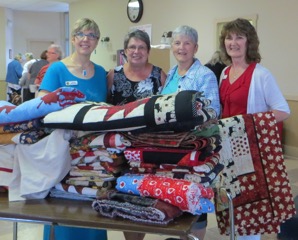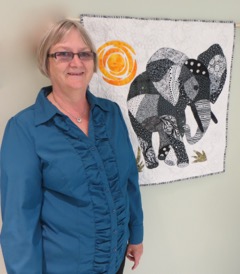To quilt label or no quilt label? Well, that’s not the question today!
Today we are giving you a label to use for the wonderful
quilts you are making for the Big Quilt Bee 2017. We have this in a few different formats so
that you can choose the one(s) you want to use:
Let's review the process of printing the quilt labels on inkjet printers (see further down the page about printing services if you prefer not to print them at home).

Inkjet printers spray the ink on to the fabric, so the trick
is to have the fabric absorb the ink and retain it, wash after wash. One of the first products to help with that
is still available is Bubble Jet Set 2000.
After soaking cotton or silk in this solution, then drying it, you press
an 8½" x 11" sheet of freezer paper to the back of the fabric. Trim the sheet and it’s ready to run through
your printer. You need to know which
side of the paper your printer prints on (usually the underside of the page in
the printer).
If you are not keen to make your own paper-backed sheets as
described above, there are several companies who sell fabric sheets that have
been pretreated to help with ink absorption then backed with a paper or plastic
to hold the fabric taut during the printing process. Your quilt shop will have at least one of these in stock.
Each of these products has explicit directions about
printing and dealing with the fabric sheets once they come out of the printer.
The sheets of quilt labels are saved as Adobe Acrobat files
(pdf), and once you download them to your computer, you can open them in
Acrobat Reader and print them out. Deal
with the labels according to the directions for the fabric sheets you are using
and then you can use a fabric pen or permanent marker (or crayon) to fill in
your name, the date and the location your quilt is coming from (this could be
just the province or the village/town/city and region). It’s usually a good idea to ‘heat set’ the
label with a hot iron to set the colour permanently.
Label Option 2:
Downloading one of the Two Images at the top of this Page and
Personalizing Them
You may have photo software such as Adobe Photoshop
Essentials and so you know how to add text to one of the jpeg quilt labels. If
you don’t, you may be interested in trying Inkscape, www.inkscape.org/ which is free software
for working with images. Download the
quilt label image (quilt_label_text.jpg) and save it on your computer. When you open Inkscape (or any other photo
software), you have a blank page to work with.
Go to File -> Open and double-click on the name of the
file to import it into Inkscape. The
image will fill the screen, so you will have to resize it. You may have to change the Document Properties
(under the File menu) to set the paper size to 11" x 8½" and the units
to inches. After setting the properties
up, you can click on the image to see the image handles and then change the
size to a width of 3.5” and height of 3.25”.
Changing the Label
You may not want to use the text the way it is set up on the
sample label. You are free to use the
‘eraser’ tool to delete the text that does not suit you and then type in your
own text.
Adding text to the quilt label
In Inkscape, click the ‘A’ on the left hand menu and click
beside ‘Made by:’. Under the top menu,
you’ll see ‘sans-serif’ and 32 – those drop-down menus offer all the different
fonts and sizes. For most regular fonts,
size 16 will fit this size label.
It doesn’t make sense to print only one quilt label on a
fabric sheet, so your options are to print out your label and 3 other blank
ones for your friends...or to copy the label and fill in the information for
them and then print the sheet!
Copying the quilt label
When printing on a fabric sheet, you can fit 4 labels or 1
‘bee’ label and other labels for yourself.
It makes sense to make use of the whole fabric sheet. Here are the directions for copying the image
and creating a sheet of 4 labels:
- From the ‘Edit’ menu, choose ‘Select All in All Layers’, then from the ‘Object’ menu, choose ‘Group’.
After those choices, click on the label and from the ‘Edit’ menu, choose ‘Copy’, then go back to the same menu and choose ‘Paste’.
Click on the image and move the duplicate copy to the other side of the page. Choose ‘Paste’, twice more so that you’ll have 4 labels spaced on the page.
Click on the ‘A’, then highlight any text (like the name) you wish to change and type the new information.
Save the file and then print it according to the directions of the fabric sheets you have.
Using a Printing Service
You may have a local Tshirt or Embroidery store near you
that will print images for you. Usually
you prepare the images according to their directions and bring them in a copy
on a flash drive. At my local store, I can
bring in a sheet of 4 labels and have them printed on a polyester fabric sheet.
On the Internet, in Canada, there are a few options for
printing on fabric:
https://designyourfabric.com
The last two print companies will print on quilting cotton. You can send them one image and they will print
anything from a swatch sample to yards - filled with labels. These are excellent options if you are
working with a large group and need a lot of blank labels that can be filled in
later on.
Label Option 3: Downloading one of the Two Images at the top of this Page then using them in a Word Processor
After downloading the images, you may choose to 'insert' or 'import' them into a word processing program (like Microsoft Word) and then you can resize the image to suit your page. If you want to print more than one label on a fabric sheet, 'Copy' and 'Paste' your image and move them on the page until you have all of them organized. Don't forget to save your page before printing!
NOTE: If all else
fails, and there’s no-one available to make up labels for you, email me at lpmacdonald@hotmail.com and I’ll
create a page of labels to your specifications.
I’ll email it back to you and you can print them out or send them out to
be printed.






































